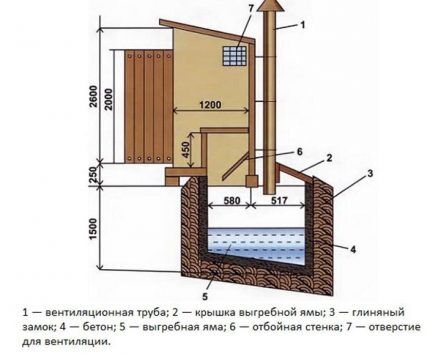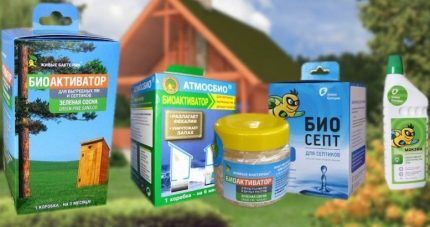Review of the Sanex line of products for cesspools: reviews and instructions for use
The installation of an autonomous sewer system in a summer cottage differs from centralized systems in that it requires constant maintenance throughout its entire length - from flush points to the cesspool. The final point requires special attention and must be vacated from time to time.
To facilitate the process of cleaning and disinfection, Sanex is used for cesspools - an effective biological preparation. This material will discuss the principle of action of the drug, its varieties and methods of use.
The content of the article:
How to solve the problem of recycling waste at the dacha?
In order to choose the right type of sewage system and ensure fast and efficient wastewater treatment, it is necessary to consider several factors, including:
- number of residents;
- permanent or temporary residence;
- total volume of wastewater;
- nature of wastewater, etc.
Ideally, the installation of a sewer system and the selection of a septic tank occurs at the design stage, but this is only possible during the construction of a new house.
More often, communications have to be redone from old ones - due to an increase in the number of permanent residents or a planned increase in the level of comfort.

It doesn’t end with replacing pipes or in-house repairs; it often requires installing a new container for collecting and processing waste.
There are four options to solve the problem:
- local treatment plant (WTP) - an automatic station that purifies 95-98% of wastewater with subsequent recycling of the liquid for economic purposes;
- three-chamber or two-chamber septic tank, having several stages of cleaning (factory or self-built);
- a storage single-chamber septic tank, from which wastewater is pumped out and partially processed into feedstock for compost.
- an absorption well with a filter bottom, which provides additional purification of wastewater treated in a septic tank as it passes through a soil filter backfill;
- cesspool – a sealed container that requires regular cleaning.
In fact, the last two options are variations of the traditional country cesspool, with the difference that the possibility of filtration creates natural purification of most of the wastewater, therefore, waste removal has to be organized much less frequently.

Each type of treatment plant has its own characteristics. For example, for uninterrupted operation of the VOC, the availability of electricity is necessary. Arranging a septic tank requires sufficient area to dig a large pit for 2-3 compartments or organize a volumetric filtration field.
To process waste in cesspools, special biological products are needed - we’ll talk about them in more detail.
The principle of action of biological drugs
Drain pit products are a viable medium, packaged in small portions (for ease of use) and available in liquid, powder or solid form. This is a complex of microorganisms, bacteria and enzymes that live off decomposing organic waste.

Before you start using bacteria for septic tanks, you need to familiarize yourself with the following information:
- In order for the biological agent to “work”, special conditions must be created, for example, ensure a favorable temperature (from approximately +4 °C to +40 °C);
- bacteria are able to almost completely recycle sewage, but only if the instructions are strictly followed (dosage, time of installation, etc.);
- the mass treated with microorganisms becomes safe and in some cases can be reused;
- the correct use of biological agents can almost completely eliminate unpleasant odors;
- bacteria are not friendly with aggressive chemicals contained in disinfectant cleaning products: chlorine, phenols, alkalis, aldehydes.
Let's look at how the process of processing plums occurs from start to finish. Microorganisms that are in a “dormant” state enter a favorable (liquid and warm) environment, become active and begin to multiply.
Colonies of bacteria live by processing organic matter, which enters the pit through sewer pipes, less often directly.

With the help of bioactivators, the contents of toilets, paper, food debris, and fat quickly decompose. At the same time, plastic or concrete, from which modern cesspools are most often made, remain untouched.
As a result of the vital activity of microorganisms, all waste is converted into water, sludge and carbon dioxide. A relatively small amount of solid sediment may form, which is subsequently removed manually.
The remaining waste is an unclarified liquid, but without a pungent odor. In a septic tank, water is purified in the second chamber and goes into the ground for further treatment. In a primitive storage tank - pumped out with a pump fecal type. The sludge-like substance is used as compost.
Types of environmental products of the Sanex brand
Sanex biological products have proven themselves over the past years and have a large audience of regular users. This is an American product that is made in Poland.
The official representative of the trademark in Russia is K&K CJSC, the office is located in Moscow. In other countries, the drug may have a different name.

The market offers a line of bioactivators for various purposes:
- Sanex – a product for country toilets and cesspools;
- EcoDrain – a preventive drug against blockages and for removing deposits in sewer lines;
- EcoSeptic – a product for cleaning waste in combined type septic tanks;
- EcoCompost – accelerator for rapid maturation of compost;
- EcoPrud – a product for maintaining the purity of water in ponds and aquariums.
As you can see, all products are created for use in a suburban area. Drugs that effectively help recycle sewage include Santex, EcoSliv, EcoSeptic. They have a similar principle of operation, but differ in the scheme of application.

EcoSeptic is designed to accelerate the process of decomposition of biological waste in any type of mixed type septic tank, that is, it may contain both anaerobic and aerobic bacteria.
One of the positive consequences of changing the biological environment is the complete or partial elimination of the unpleasant odor characteristic of primitive sewerage structures.

Bacteria are able to multiply and secrete the enzymes necessary for “digesting” wastewater only at above-zero temperatures (the exact parameters are usually indicated on the packaging). Therefore, to increase efficiency, you need to take care of the thermal insulation of the septic tank or install it below the seasonal freezing zone of the soil. The same requirements apply to the cesspool, which we will discuss in more detail.
Sanex cleaner for cesspools
If your dacha does not have an automatic treatment plant, and the only reservoir for sewage is a regular cesspool, we recommend regularly using the Sanex bioactivator.
Advantages and disadvantages of the drug
If you have ever used products to speed up the decomposition process of biowaste, the principle of operation of Sanex will seem familiar to you.
The bacterial strains and enzymes that make up the powder or liquid substance act in the same way - they quickly process cellulose, starch, fats, plant fibers, that is, any products of organic origin.
The main advantage is an increase in comfort, which consists in simplified maintenance of the cesspool. Instead of regularly calling vacuum cleaners, an easy procedure for adding the substance will be required.
If the processing process is started and established, the result will be obvious quite quickly - within a couple of weeks. The first sign is the disappearance of a specific “aroma”.

The list of the main advantages of the bioactivator, noted by regular summer residents, is as follows:
- accelerating the process of processing wastewater and sewage waste;
- the possibility of reusing decomposition products (activated sludge and liquid that has undergone an additional clarification stage);
- maintaining an ecologically balanced microclimate at the dacha site;
- the optimal ratio of effective cleaning and minimal costs for its organization;
- absence of chemical components in the composition of the substance used.
When using Sanex, there will be no risk of contamination of the surrounding area, including soil intended for gardening. The wastewater entering the ground after biological treatment is absolutely safe.
The manufacturer guarantees that the volume of solid sediment that accumulates over time at the bottom of the tank will not disturb the residents of the house for a long period, since it occupies only about 3% of the total volume of sewage.
This means that the services of vacuum cleaners will still be required, but not every 1-2 months, as usual, but once every 5-7 years.

If you decide to clean the drains in a cesspool that is already almost full, you will need at least 3-4 months. It is better to start the biological treatment process when the container is at least half full.
Disadvantages of use are usually considered to be the fastidiousness of microorganisms, the reproduction of which requires a favorable environment: a special temperature range, a sufficient amount of liquid, and for some species, access to oxygen. Sometimes you have to completely change the usual range of cleaning products used in the household.
The main disadvantage is inadequate wastewater treatment, but this is impossible even with multi-level treatment in VOCs.
Detailed instructions for use
The bioactivator can be purchased at a specialized store or on the website of an intermediary company. It is sold in small, easy-to-use packages weighing 100 g. and 400 gr.For calculations and dosing, you usually take a dessert spoon, the volume of which is 10 grams.
Any product of this type is supplied with detailed instructions, which indicate when, how and in what proportions the product should be added to the storage tank.

There is such a thing as a starting dose. This is a certain amount of product that is needed to start the waste recycling process. It depends on the type of cesspool and its volume.
According to the manufacturer’s conditions, all tanks can be divided into three categories:
- standard type country toilets located outside the residential building;
- cesspools without drainage;
- drainage pits with a filter bottom (drainage).
Thus, in order to activate the process of bioprocessing of waste in a country toilet with a pit of 2-3 m³, you will have to use a starting filling of 50 grams, that is, 5 dessert spoons. For a cesspool without drainage with a volume of up to 6 m³, 120 g will be required, for a drainage pit with filtration with a volume of 12 m³ - 160 g.
The starting dose is higher than the monthly supplements, since the “work” for bacteria in the first stage is much greater, and some of them may die. Subsequently, the regular dose is reduced. The exact numbers are indicated in the instructions in the form of a table:

Then mix the contents thoroughly, leave for about half an hour and pour directly into the sewer sump.If you have a toilet installed at home, you can use it to fill it.
The recycling process will start faster if, for the first time after the starting filling, you limit the amount of household waste associated with washing or cleaning the premises. The basic principle of high-quality cleaning is more organics, less chemicals.

User reviews
Many summer residents do not trust advertising campaigns and draw conclusions about the effectiveness of a particular drug based on reviews from people who have previously used Sanex. Recommendations can also be subjective, so it is better to focus on real facts, for example, the experience of a neighbor in the country using a bioactivator.
You can see with your own eyes the result of biological processing and decide whether the products of this brand are suitable for your cesspool.
Sanex is one of those products that has long been popular among summer residents, so finding an environmentally friendly pit is not difficult. Pay attention to the presence of odor and ask how often the sediment is removed.
If you are satisfied with the answers and the visual example, try conducting the experiment in your area. In approximately 90% of cases, beginners are completely satisfied with the result.

Cost and calculation per year
Now the drug can be purchased in packages of 100 grams.or 400 gr., the most common products are Polish-made. For January 2017, packages are 100 g. cost from 230 to 300 rubles, 400 g. – from 630 to 810 rubles.
Pay attention to small wholesale quantities, convenient for purchase and use. As a rule, the seller reduces the price for a set of 4, 6, 10, 20 packages, as a result, you can additionally buy a couple more pieces. For example, if the price for 1 package is 630 rubles, then 20 will cost you 530 rubles each. a piece.

You can calculate the amount of bioactivator for a specific cesspool using the table. For example, if you have a regular outdoor toilet, a large 400 gram bag will last for the next year (12-14 months), and then you will need even smaller quantities in the future.
Useful recommendations and tips for summer residents
Even strict adherence to the instructions does not always give a 100% result; sometimes you have to deal with nuances that are not described in the application. More experienced fellow summer residents will help you solve minor problems.
Here are some tips:
- Do not worry about changes in the liquid level in the sump - it can decrease due to the action of the bioactivator or increase due to a decrease in the permeability of the drainage layer. The groundwater level also has some influence.
- If the amount of treated wastewater seems large, use a drainage or fecal pump to pump it out.
- In winter, biological processing may be suspended due to severe frosts: insulate the pit or wait for a thaw.
- It is better to hide drugs that are safe for health away from children and animals - they are not intended for oral administration.
- Don’t be surprised if your “sealed” pit suddenly begins to leak liquid into the soil - over time, the bacteria also cleanse the bottom, denser layer of waste.
- To soften hard, old sediment, add more liquid.
As you can see, maintaining a septic tank with additional biological treatment is not difficult.
Conclusions and useful video on the topic
With the help of the following videos you can expand your knowledge about products for country toilets.
Experience in the practical use of biological products:
Using a product based on nitrate oxidizing agents:
If your summer cottage has a cesspool that requires regular cleaning, be sure to use the Sanex bioactivator. It will not only save you from regular communication with sewer men, but will also improve the environmental situation at your dacha, and this is very important for both a comfortable stay and a good harvest.
Please write comments in the block below. Perhaps you have experience using the Sanex bioactivator and you can share your impressions or tell the nuances of using the drug to our readers.




We know Sanex well; we have been using it for a long time in a cesspool in an outdoor toilet. At first it was a banal pit, and in the summer everything was fine, but in the spring it became clear that the bacteria could not stand the frost and died. So I bought a septic tank and insulated it. This solved the problem. Once in three years we pumped out solid sludge, and even that was not enough for our own peace of mind.Now I’m installing sewerage into the house, including the kitchen, and I’m thinking about the question of what to do with the amount of household chemicals that will go down the drain. Should we make a separate septic tank for the “non-toilet” sewage system, or should we just put a ditch in the forest behind the dacha?
Hello. Bacteria, as you correctly noted, will die from household chemicals. Therefore, the option of discharging wastewater to another location is advisable if it is available and you are not going to use pumping.
In general, the dacha is not for year-round living or do you live there? It just wouldn’t have time to fill up so quickly... But in any case, I categorically do not advise you to take the ditch into the forest. Especially in SNT. If they are found out or slandered, they will be robbed of fines.
A problem similar to yours, Sergey, is easily solved in one-story Europe. There is one pit for the toilet, another for wastewater. Accordingly, the drugs are different. Our Expert says absolutely correctly - take the wastewater to another place, and use SANEX or some other bacteria-based drug for the contents of the toilet.
For a novice summer resident - a treasure trove of information. I had an experience with EcoPrud when I was faced with the problem of constant pollution of the pond. I can say with confidence that the product is effective. It helped me tremendously. I haven’t tested the rest, since I still don’t get around to tackling the sewage system in my dacha. I hope this will solve the problem, otherwise constantly calling a vacuum cleaner is such a hassle.
Hello. Tell me, is it possible to wash the toilet with Domestos or Toilet Duck after using Sanex?
Hello. Biological products are strictly not recommended to be combined with chemical cleaning agents.
I have been using SANEX for over 10 years. It was nice to come across such an objective review. I would like you to mention that in addition to the Polish Sunex that you are talking about, Ukrainian Sunex of Canadian origin has recently appeared on the market, which is supposedly real. I tried it too, but this “remake” didn’t stick with me. The conclusion suggests itself: It’s good to know Polish Sanex if it has already been counterfeited!